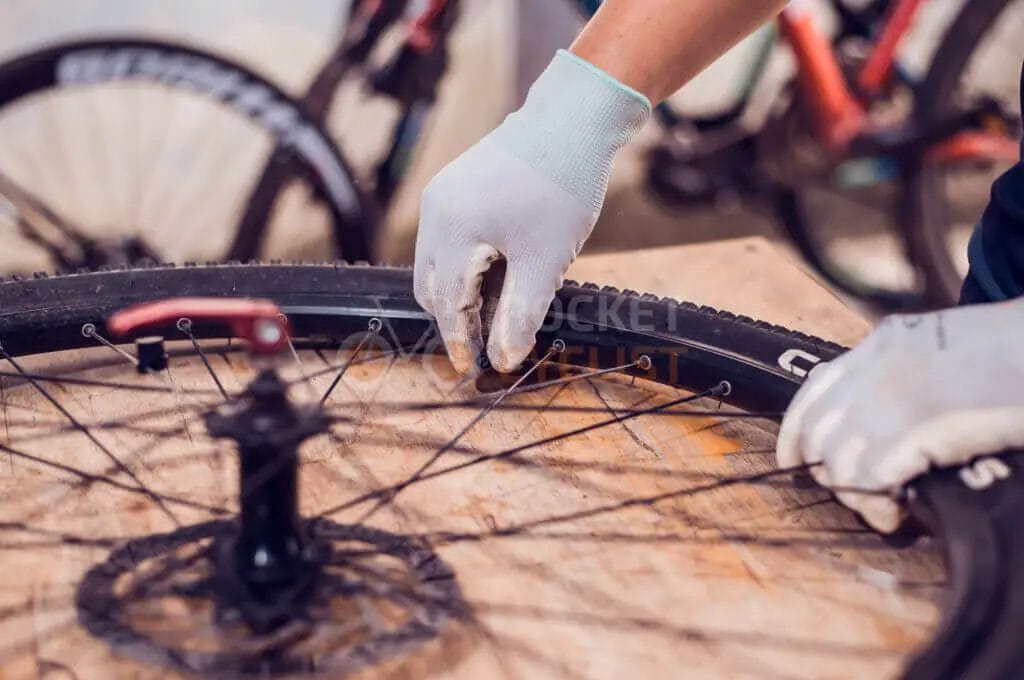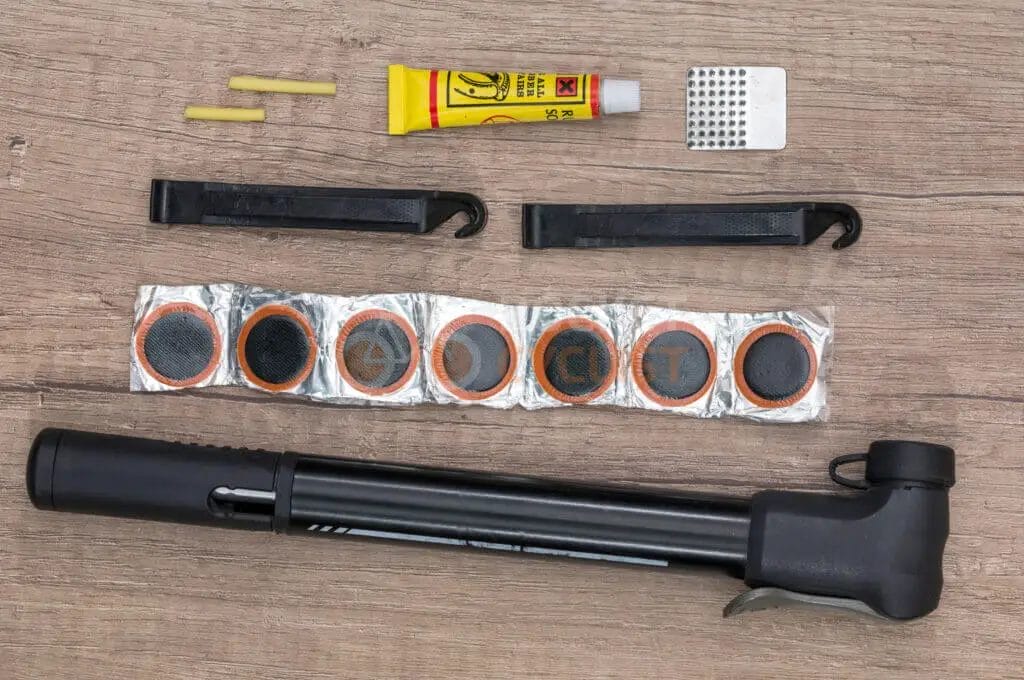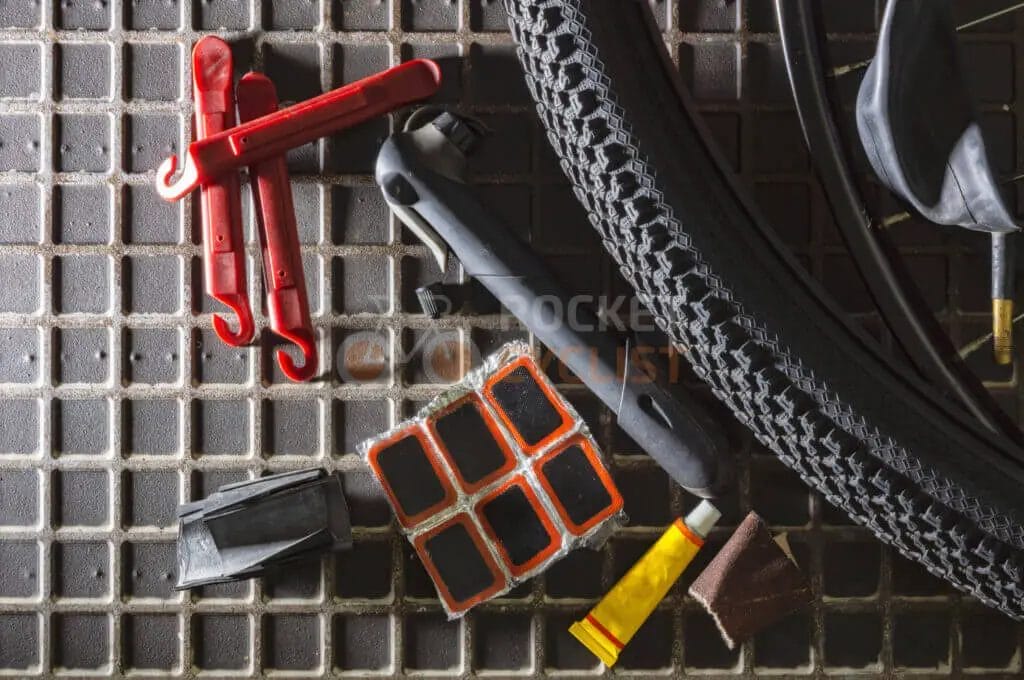Last Updated on September 12, 2023 by Vinson Lozano

When it comes to fixing a flat tire on your bicycle, you have a couple of options: glueless patches or traditional glue patches. In this article, we’ll explore the differences between these two methods and help you decide which one is best for you.
Glueless patches have gained popularity in recent years due to their convenience and ease of use. These patches come pre-coated with adhesive, eliminating the need for messy glue application. Simply peel off the backing, apply the patch to your punctured tube, and press firmly to ensure a secure bond. This method is quick, hassle-free, and perfect for on-the-go repairs.
On the other hand, traditional glue patches have been a go-to method for many cyclists for decades. With this method, you’ll apply a layer of rubber cement to the tube and the patch before pressing them together. While this process may require a bit more time and patience, it can provide a stronger and longer-lasting repair.
Whether you’re a seasoned cyclist or a beginner, understanding the differences between glueless and glue patches will empower you to handle flat tires with confidence. So, let’s dive into the world of puncture repairs and help you make an informed decision on which method is right for you.
The importance of bicycle tire maintenance
Had a sudden flat tire while enjoying a ride? That’s such a bummer! You might feel like tire maintenance is just another chore to add to a long list, but trust me, the small effort it requires regularly will save you big time from unwarranted interruptions. Giving your tires a once-over before each ride can help prevent flats and allow you to address minor issues before they turn into major ones.
Overview of glueless and glue patches
When it comes to patching up a flat, glue patches and glueless patches each have their advantages. Glue patches have been around for decades and are praised for their super-strong bond. They’re a bit more labor-intensive as you’ll need to apply the adhesive, wait for it to become tacky, and then apply the patch.
On the other hand, glueless patches are the newer kids on the block. They are easier to use, as they adhere to the tube without the need for a separate adhesive. However, some cyclists believe that they may not seal as strongly or last as long as the traditional glue patches.
So the choice is really down to your personal preference: Whether you value the robustness and reliability of glue patches or the convenience and speed of glueless patches. Both will help you get back on your wheels and continue pedaling your journey!
Glueless Patches
Listening to your favorite podcast, zooming down your familiar route, you feel the dreaded bicycle bump. Oh no, it’s a flat tire! Thankfully, you remember your glueless patches, and with a sigh of relief, you start patching up. Now, you might be wondering what exactly are glueless patches?
How glueless patches work
They’re the perfect companion for cyclists who want to fix their tires quickly and efficiently. These little miracles perform similarly to traditional patches but without the mess of the glue. They employ a pressure-sensitive adhesive that sticks firmly onto the tube’s rubber surface as soon as pressed onto it. It’s as simple as peel, stick, and you’re ready to roll again!
Pros and cons of using glueless patches
Speed and convenience come to mind when thinking about the advantages of glueless patches. Their easy-to-use design often means a faster repair process, great for those on-the-go repairs. However, as every rose has its thorns, so do glueless patches. While they’re great for temporary fixes, due to their lower adhesion levels, they might not hold as long as glue patches, especially in wet or harsh conditions.
Step-by-step guide on using glueless patches
Repairing with a glueless patch involves a few simple steps:
- Find the puncture: First, identify where the hole is located on your tire.
- Prepare the area: Scuff the area around the hole to remove any dirt or grease.
- Apply the patch: Peel off the protective film from the patch and stick it directly onto the punctured area.
- Apply pressure: Apply firm pressure over the patch for at least 30 seconds to ensure good adhesion.
- Get back on the road: Reinflate your tire and you’re good to go.
Armed with glueless patches, you’re one step closer to being prepared for unexpected hiccups on your cycling adventures. It’s your trusty partner in making sure the journey continues, no matter the bumps on the road. But remember, even the best patch can only go so far, and regular tire maintenance is key to smooth rides.
Glue Patches

You’ve undoubtedly heard of glue patches if you’re an avid cyclist – these little saviours can definitely save the day!
How glue patches work
Glue patches are designed to create a strong bond with your bicycle’s inner tube, helping to seal puncture wounds. You apply the glue to the damaged area, let it somewhat dry, then firmly press the patch over the glue. The chemical bond between the glue and the rubber creates a virtually permanent seal.
Pros and cons of using glue patches
Glue patches offer a solid and reliable fix, making them a popular choice. They’re inexpensive, and their dependable bond ensures that once the patch is on, it’s not coming off. However, they can be messy to apply, requiring preparation and drying time. Also, incorrect application or usage can lead to patch failure.
Step-by-step guide on using glue patches
- Find the puncture: First things first, you need to find the source of the puncture.
- Prep the area: Once you’ve found the puncture, roughen the area around it with the provided sandpaper.
- Apply Glue: Apply a thin layer of glue over the area, doing your best not to over or under-apply.
- Let it dry: Allow the glue to become slightly tacky – the drying process normally takes about 5-10 minutes.
- Put on the Patch: Firmly press the patch over the glue, ensuring all edges are down.
Glue patches are time-tested, reliable, and a great solution for a bike lover like you, wanting to get back on the track as soon as possible!
Comparison between Glueless and Glue Patches

So, you’re a cycling enthusiast, right? There are a few certainties in life as a cyclist – and one of those is punctures. In the quest to be a self-sufficient cyclist, knowing how to utilize bicycle patches, both glue and glueless varieties, can be incredibly handy. Let’s explore their differences.
Durability and longevity
Glue patches are the traditional choice, offering an excellent seal, thus making them highly durable and long-lasting. On the other hand, glueless patches serve you well in a pinch, but they lack the same lifespan as their glue counterparts. However, you shouldn’t dismiss glueless patches entirely as they’re perfect for quick fixes, enabling you to resume your ride in no time.
Ease of use and convenience
You’re on a cycle route and encounter that dreaded puncture. Then you’d appreciate the super-speedy, mess-free application of glueless patches. For a quick and easy repair, you simply peel and stick! No waiting time for the glue to dry. However, with glue patches, a bit more effort, time, and skill are required for the application – but for some, that’s part of the whole bicycle maintenance experience!
Effectiveness in repairing different types of punctures
Although, when it comes to dealing with larger or irregular holes, glue patches have the upper hand, offering a better seal to keep your tube airtight. So, for those gnarly punctures, a glue patch might be your best bet.
For a summarized comparison of the two patch types, see the table below:
| Patch Type | Pros | Cons |
| Glue patches | Durable and long-lasting, better seal for large or irregular punctures | Requires more time and skill to apply |
| Glueless patches | Quick, easy and mess-free application | May not last as long, less effective for larger punctures |
Whether you choose glueless or glue patches, understanding their pros and cons helps you make an informed choice for your cycling needs.
Factors to Consider When Choosing Between Glueless and Glue Patches
Remember the feeling of freedom you relish every time you ride your bike? Well, nobody likes the sudden halt brought about by the unfortunate event – a tire puncture.
To keep your journey going, having the right patch kit is indispensable. Here, we’re discussing two types, glueless and glue patches. Each comes with its advantages, but your choice should depend on the specific needs of your bicycle and your patching skills.
Tire type and intended use
Different tires for different rides, is a great phrase to remember. Are you a casual rider or a professional cyclist? The type of tire you ride and the amount of pressure it holds can significantly influence your patch decision. Glue patches might work better for high-pressure road tires, but if you are commuting on wide, lower pressure tires – glueless patches could be the magic solution to your puncture woes.
Skill level and experience
Handy or not, your dexterity matters when it comes to patching a tire. If you are a newbie to the world of bicycle maintenance, or you simply enjoy a quick fix, glueless patches could be the way to go. But if you’ve earned your stripes and not scared of getting your hands a little dirty, traditional glue patches might be more up your alley.
Availability and cost
Fast or Frugal? Glueless patches are readily available at bike shops and offer a quick-fix solution. However, their life span isn’t always as long as a glue patch. The trade-off might be a higher upfront cost for traditional glue patches, but they could offer a longer-lasting and more reliable fix in the long run.
Remember, both glue and glueless patches are just tools to get you back on your journey. Your choice should depend on your comfort level, type of tire, and individual circumstances. Happy cycling!
Conclusion
When it comes to repairing a flat tire on your bicycle, both glueless and glue patches can be effective solutions. The choice between the two depends on your personal preferences, the urgency of the repair, and your level of experience with bicycle maintenance.
Final thoughts on glueless vs glue patches for bicycle tires
Glueless patches are convenient and easy to use, making them a popular choice among casual riders or those who want a quick fix without the hassle of glue and drying time. They are great for emergency repairs on the go. However, they may not provide as secure and long-lasting a repair as glue patches.
Glue patches, on the other hand, offer a more permanent fix and are especially suitable for professional or frequent riders who want a sturdy and reliable repair. They require more time and effort to apply, but they provide a stronger bond to the tire. It is crucial to follow the instructions carefully and allow the glue to dry fully before reinflating the tire.
Recommendations based on different scenarios
- For casual riders or occasional use: Glueless patches are a convenient option for quick and temporary repairs.
- For professional riders or frequent use: Glue patches offer a stronger and more durable solution for long-lasting repairs.
Frequently Asked Questions (FAQs)
Q: Are glueless patches as reliable as glue patches?
A: While glueless patches can provide a temporary fix, glue patches offer a more secure and long-lasting repair.
Q: Can I use glueless patches for all types of punctures?
A: Glueless patches are suitable for small punctures and cuts. For larger or more severe damage, glue patches may be a better choice.
Q: How long does it take for glue patches to dry?A: It depends on the brand and specific product. Read and follow the instructions carefully for the recommended drying time.


